Since ancient times, people have wondered about the origin of the universe and the Solar System. What place does our Planet Earth occupy in the universe? What is the Sun? What is the size of the Earth? Do stars move? We are going to explain Planet Earth for children in an easy and complete way.
Research carried out by scientists of all times came to describe the planet Earth and the Solar System. The Earth belongs in the Solar System. This is the Sun and all the smaller bodies that revolve around it. The Solar System is made up of a variety of bodies: planets, satellites, asteroids, dwarf planets, comets, and a large star, the Sun.
Earth Facts for Kids: Summary
Table of Contents
Our planet, Earth, is the third planet in the Solar System and it is the largest of the four terrestrial planets. The terrestrial planets are: Mercury, Venus, Mars and Earth. Terrestrial planets are those with a rocky and hard surface. The composition of the Earth is similar to that of the other terrestrial planets, it has a core surrounded by a mantle and an outer crust.
Fun Facts about Planet Earth
Between the Earth and the Sun there is an average distance of 150 million kilometers (93 million miles). It is just at the right distance for water on the Earth’s surface to remain in a liquid state. If the Earth were closer to the Sun, the water would take the form of vapor, and if it was farther from the Sun, the surface water would freeze and turn to ice. This factor is fundamental for the conservation of life of the beings that inhabit the Earth, since they need water in a liquid state as it is found in all cells.
The Earth formed at the same time as the Sun and the rest of the Solar System, 4.57 billion years ago. Together with its natural satellite, the Moon, our Planet Earth completes its elliptical orbit around the Sun in 365 days and 23.9 hours.
Why is Earth called the Blue Planet?
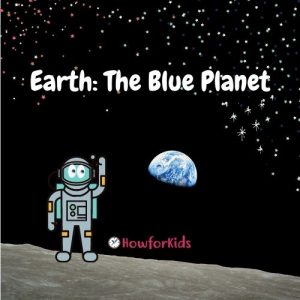
Among all the planets in the Solar System, only Earth has a large amount of liquid water and a layer of air that covers it and allows us to live.
Earth was called the “blue planet” because seen from space, it looks like a blue sphere. The photos captured by astronauts, on a space mission in 1969, photographed the earth from the moon and it is seen as blue. It is due to the large masses of water that cover the surface, formed by oceans, rivers, lakes and the frozen water at the poles, and to the gases in the atmosphere.
Read also: The Universe for kids
Earth Characteristics
We inhabit this planet, which is very different from the rest of the planets that make up the Solar system. There are many things that make Earth unique among the planets in the Solar System.
- Earth is the only planet we know of that contains life and supports millions of different life forms.
- Another difference is that the Earth is mostly covered in water. Earth is the only planet that has liquid water on its surface. About 71% of the Earth is covered with oceans of salt water.
- Furthermore, Earth’s atmosphere is composed primarily of nitrogen and oxygen, while the atmospheres of Venus and Mars are composed primarily of carbon dioxide.
Geography of the Earth
The Earth has seven broad landmasses called continents. Continents include Africa, Asia, North America, South America, Europe, Oceania, and Antarctica. It also has the main Atlantic, Pacific, Indian, South and Arctic oceans.
The size of the Earth is more than a million times smaller than the Sun and the mass of the Earth is nine times that of the Moon.
The average temperature of the earth’s surface is about 59°F or 15 ºC.
The Shape of the Earth: Geoid
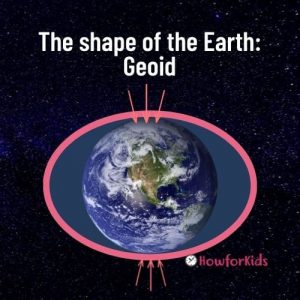
Since ancient times, various cultures had different ideas of what the Earth was like. Many ancient civilizations held that the Earth was flat. Over time, they discovered that the world is spherical.
The Hindus believed that it was a plate supported by four elephants on a giant tortoise. Travelers and explorers with the naked eye, observed that the ships, when they moved away, disappeared, as if they turned somewhere. Over the years, the conclusion was reached that the Earth was not flat and it is not a perfect sphere.
The actual shape of the Earth is called a geoid. It is flattened at the poles and bulging at the equator. Currently, artificial satellites from space and spacecraft have photographed the Earth.
Geographic Coordinate System for kids
The geographic coordinate system is used to locate a place on Earth. It is a network of conventional imaginary lines that are drawn on the earth’s surface in order to locate a specific place.
These lines are called meridians and parallels. Every place on earth is crossed by a meridian and a parallel.
Latitude is measured from 0º to 90º from the Equator to the positive north and negative to the south.
Longitude is measured with the meridians.
Read also: Latitude and longitude for Kids
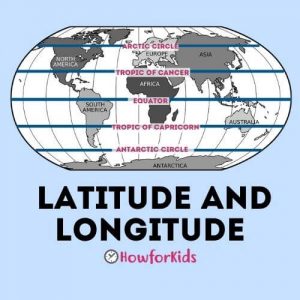
The meridian that passes through Greenwich, in England, where a famous observatory is located, has been chosen as a reference. The longitude in the Greenwich meridian is equal to 0º.
The Central Parallel is the Equator, which measures 0º and divides the Earth into two hemispheres, North and South.
The Tropics: Two other important parallels are the Tropic of Cancer in the Northern Hemisphere and the Tropic of Capricorn in the Southern Hemisphere.
The Arctic Circles to the North and Antarctic to the South.
The Earth´s Spheres
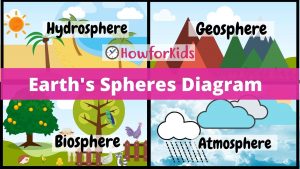
Planet Earth is made up of different parts that relate to each other, depend on each other and influence each other. Studying the world as a whole is complicated. To do this, it is divided into terrestrial subsystems. Any change in one of them affects the rest: Hydrosphere, Geosphere, Biosphere and Atmosphere.
Hydrosphere
It is the layer formed by the water that covers the Earth in the form of seas, oceans, lakes, rivers, the frozen water of glaciers and the poles. Groundwater, water from the atmosphere and from living beings as well. Living things contain a large proportion of water in their bodies. 97% of the water on planet Earth is salty, only 3% is fresh. For this reason we must take care of the water, not contaminate it, or waste it.
Geosphere
It is the part of our planet made up of the earth’s crust and the interior of the earth (mantle and core)
Structure of the Earth: Diagram
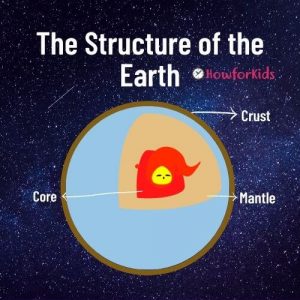
Surface and Structure
The earth is made up of three large layers: Crust, Mantle and Core.
The Crust
It is the outer layer formed by rocks, the continents and the bottom of the oceans. This layer is divided into two parts: an external one (composed of silicon and aluminum) and an internal one (composed of silicon and magnesium).
The Mantle
Located below the crust, this layer is composed of silicates, iron and magnesium.
The Core
It is the deepest layer of the Earth, there it is so hot that the rocks have melted.
Biosphere

The biosphere is the system formed by the set of living beings that inhabit planet Earth.
Atmosphere
It is the layer of air that surrounds the Earth. It is made up of gases such as oxygen, which is essential for life, nitrogen, small portions of carbon dioxide (CO2) and other gases. The function of the atmosphere is protection, it acts as a protective shield that filters the sun’s rays. Clouds form in the atmosphere, which are condensed water vapor that will give rise to rain. The atmosphere is made up of 5 different layers.
Read also: Earth Atmosphere Layers
- Troposphere.
- Stratosphere.
- Mesosphere.
- Thermosphere.
- Exosphere.
Earth Atmosphere Layers
The air we breathe is made up of a mixture of gases that varies according to the height of the atmosphere. Oxygen is one of the gases in the atmosphere and is used by living beings during the breathing process.
Read: Respiratory system.
The Earth Movements: Rotation and Revolution
The Earth exerts a force that attracts objects around it. It does not need to be in contact with the objects, nor does it depend on the weight of the objects. As we move away from Earth, the force of gravity decreases and objects weigh less. The force exerted by the Earth at a distance on other bodies is called the force of gravity.
What is the Gravity of the Moon vs Earth?
On the Moon people weigh less, because the force of gravity is less. The Moon also suffers from the force of gravity, it is attracted by the Earth. That is why it always rotates at the same speed. If the force of gravity did not exist, the Moon would move away until it disappears.
Read also: The Phases of the Moon
Did you know that the Earth is always moving? Let’s take a look at the movements of the Earth, rotation and translation.
Earth’s Orbit and Rotation Definition
Yes! Our planet is not still, the Earth moves. Our planet makes two types of important movements, which are the result of day and night and the seasons of the year. Rotation and Translation, let’s explain each one.
Rotation
Earth’s rotation on its axis occurs every 24 hours. It is the movement of the Earth on its own axis. The axis is an imaginary line that passes between the two poles, north to south. It is called day when it is illuminated by the sun and when it is in shadow we call it night.
Revolution
The Earth orbits around the sun every 365.25 days. It is the movement that the Earth is making around the sun. It traces an orbit in which it takes 365 days and 6 hours, one year. Every 4 years, it has 1 more day, 366 days, this is called a leap year.
The other planets also make these movements, but the days and years for each planet are different.
Because the Earth’s axis is tilted, the sun’s rays do not reach the northern hemisphere in the same way as the southern hemisphere. They hit the surface at different angles, therefore, with different intensity. Where these rays strike more inclined, the intensity of the heat is lower because it expands to a larger surface and lower temperatures (winter). On the other hand, in places where the sun’s rays strike more directly, with a lower angle of inclination, temperatures are higher (summer).
Perihelion and Aphelion
- Perihelion is the closest point in Earth’s orbit to the Sun.
- Aphelion is the point in Earth’s orbit that is farthest from the Sun
Days and Nights
Different places in the Earth experiences different lengths of night and day. The length of days and nights are also different in different parts of the planet. At the poles, for six months of the year, they remain at night and the other six months remain illuminated by daylight.
When it is summer in the northern hemisphere, it is winter in the southern hemisphere. The sun’s rays shine more directly to the north and the days are longer than the nights.
When it is winter in the northern hemisphere and summer in the southern hemisphere, the sun illuminates the southern hemisphere more directly. The days get longer in the southern hemisphere.
In the autumn and spring seasons, the sun’s rays fall in almost the same proportion in both hemispheres, the days and nights last almost the same.